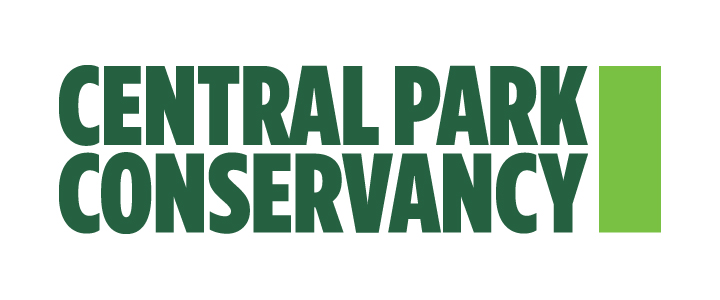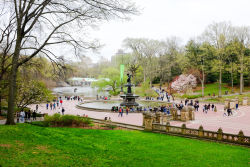Central Park
Central Park Zoo
Central Park’s zoo was almost not meant to be. Park designers, Frederick Law Olmsted (1822-1903) and Calvert Vaux (1824-1895) excluded any zoo from their 1858 plan Yet, as park construction began a bear cub was left with park messenger boy, Philip Holmes. Holmes took care of the bear, and soon an ad hoc collection of animals grew in and around the park’s headquarters at the Arsenal.
The Park Board sought an alternate location that would not compromise the pastoral landscape. State law in 1861 authorized that a “portion of [Central Park], not exceeding sixty acres [be set aside] for the establishment of a zoological garden…” Vaux prepared a plan for Manhattan Square, today the site of the American Museum of Natural History. Olmsted suggested moving the menagerie to the park’s northwest portion and placing paddocks for grazing animals dispersed around the park. The commissioners authorized, and then halted construction of a new menagerie at the north meadow.
All told, politics and budget constraints sabotaged a dozen proposals, and the animals—as if by squatters’ rights became permanent residents behind the Arsenal. Prominent citizens such as financier August Belmont, inventor Samuel Morse, and impresario P.T. Barnum donated various animals. General Custer gave a rattlesnake, and General Sherman offered an African Cape buffalo, one of the spoils of his march through Georgia. The Menagerie was also the scene of rare births in captivity, such as the South American peccary born in 1866.
Victorian structures sprouted on the grounds under the direction of William Conklin, the Menagerie’s director from the 1860s through the 1880s. The public responded enthusiastically; daily attendance was 7,000 people by 1873, and annual attendance by 1902 was reported at three million! Yet despite improvements made around 1900 to improve care and the environment, the animals’ best interests were not always served. It was not until the appointment in 1934 of Robert Moses (1888-1981) as first citywide parks commissioner, that the adverse conditions were addressed.
Under Moses, the in-house Parks design team, headed by Aymar Embury II, designed a new brick and limestone “picture-book zoo” in an astonishing 16 days; construction took a mere 8 months. The zoo was structured as a quadrangle with a sea-lion pool at its center. Additional bird and monkey houses flanked the Arsenal to north and south, and a large restaurant, known as Kelly’s Café, stretched along the back. An elaborate program of animal art included a bronze dancing goat and bear by Frederick G. R. Roth, limestone reliefs and a painted mural by Roth and his assistants, and wrought-iron weathervanes by sculptor Hunt Diederich. Moses stressed that only healthy animals in more humane circumstances would henceforth be displayed. The zoo opened with great fanfare on December 2, 1934, and former Governor Alfred E. Smith was designated honorary zookeeper.
Yet despite efforts to modernize, the public was still aware of squalid conditions in the zoo. Some advocated for a model farm, where city kids could see domestic rather than exotic animals. Fifth Avenue tenants complained about the noise and smells. Many found the succession of spare cages depressing, and by the 1970s it was clear that the zoo was retrograde. In 1980 Parks entered into an agreement with the New York Zoological Society (today the Wildlife Conservation Society) to manage the Central Park Zoo, as well as city owned zoos.
Given the small site (5 ½ acres compared with a national zoo average of 52 ½ acres) NYZS tried a new approach. Large animals were given more space or removed altogether. The NYZS, which in 1941 pioneered the principle of exhibiting animals by continents, maintained the quadrangle format of the 1930s zoo, but adopted a plan of three “biomes”—tropical, temperate, and polar. Architect Kevin Roche integrated old and new elements, while conforming to contemporary principles of animal care.
Except for four perimeter buildings, the old zoo was demolished in 1983. The artworks or facsimiles were incorporated into the new layout. Reopening on August 8, 1988, the new zoo features a naturalistic tropical zone, larger bear lair bear environment, and Japanese snow monkey island. The sea-lions exhibit remains. Lavish plantings laid out by public garden designer Lynden Miller, transform the place into a true zoological garden. In 2009, the Allison Maher Stern Snow Leopard Exhibit was introduced in the northwest portion of the zoo, designed by Quennell Rothschild & Partners as a naturalistic snow leopard environment.
Check out your park's Vital Signs
Clean & Safe
Green & Resilient
Empowered & Engaged Users
Share your feedback or learn more about how this park is part of a
Vital Park System

Know Before You Go
Anticipated Completion: Spring 2024
Anticipated Completion: Spring 2025

Contacts
Central Park Information: (212) 310-6600
Central Park Information (for the Hearing Impaired): (800) 281-5722
Belvedere Castle, The Henry Luce Nature Observatory: (212) 772-0210
The Charles A. Dana Discovery Center: (212) 860-1370
The Dairy Visitor Center and Gift Shop: (212) 794-6564
North Meadow Recreation Center: (212) 348-4867
Loeb Boathouse (Bike rentals, boat rentals & gondolas): (212) 517-2233
Carousel: (212) 879-0244
Fishing at Harlem Meer (Catch & Release): (212) 860-1370
Harlem Meer Performance Festival: (212) 860-1370
Horseback Riding - Claremont Stables: (212) 724-5100
Metropolitan Opera (Performances on the Great Lawn): (212) 362-6000
New York Philharmonic (Performances on the Great Lawn): (212) 875-5709
Shakespeare in the Park - The Public Theater at the Delacorte Theater: (212) 539-8655
Central Park SummerStage: (212) 360-2777
Swedish Cottage Marionette Theater: (212) 988-9093
Tennis: (212) 280-0205
Weddings, Ceremonies and Photography at the Conservatory Garden: (212) 360-2766
Wildlife Center & Tisch Children's Zoo: (212) 439-6500











